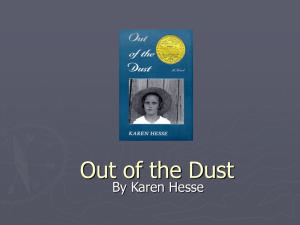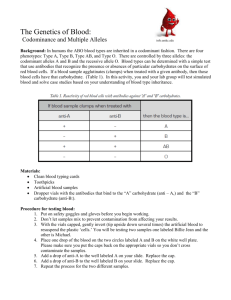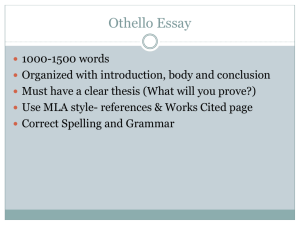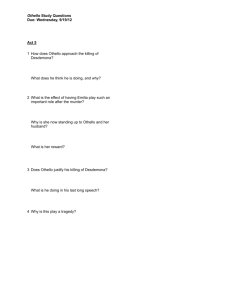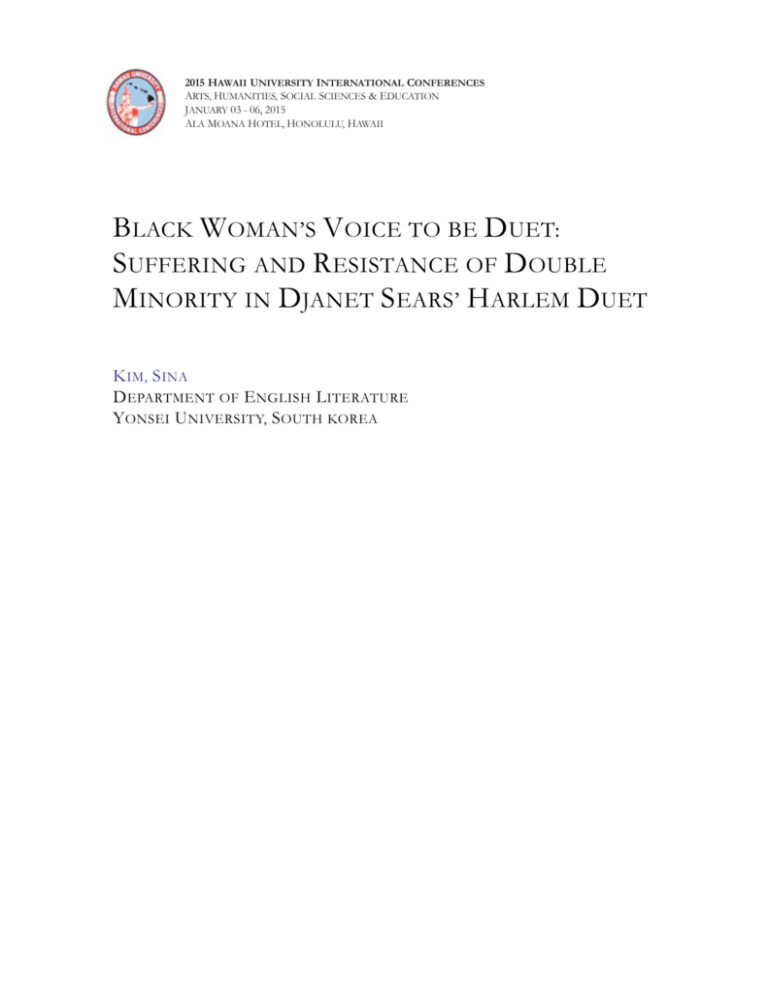
2015 HAWAII UNIVERSITY INTERNATIONAL CONFERENCES
ARTS, HUMANITIES, SOCIAL SCIENCES & EDUCATION
JANUARY 03 - 06, 2015
ALA MOANA HOTEL, HONOLULU, HAWAII
BLACK WOMAN’S VOICE TO BE DUET:
SUFFERING AND RESISTANCE OF DOUBLE
MINORITY IN DJANET SEARS’ HARLEM DUET
K IM, S INA
D EPARTMENT OF E NGLISH L ITERATURE
Y ONSEI U NIVERSITY, S OUTH KOREA
Ms. Kim Sina
Department of English Literature
Yonsei University, South Korea.
Black Woman’s Voice to Be Duet: Suffering and Resistance of Double Minority in
Djanet Sears’ Harlem Duet
Synopsis:
This paper firstly focuses in "Harlem Duet," the adaptation of Shakespeare's "Othello," on that
Othello, a black man's desire for white recognition excludes black women both racially and
sexually. “Secondly, this paper argues that the female protagonist's failure of resistance shows
the racial boundary shaped by white has been enrooted within black people's lives.
Kim 1
Black Woman’s Voice to Be Duet: Suffering and Resistance of Double Minority in Djanet
Sears’ Harlem Duet
Sina Kim (Yonsei Univ, Korea)
Djanet Sears’ Harlem Duet (1997) sheds light on the twofold oppression of Black
women who belong to both sexual and racial minority, and prescribes an alternative to free
them from such a double bondage. Both by postcolonial and feminism discourses, Black
women have been deprived of their voices. Thus, Harlem Duet is Sears’ compensation for it,
and its form of rewriting Shakespeare’s Othello is appropriate for this intention. In “An
interview” with Mat Buntin, Sears advises a student working on Shakespearean adaptation to
“find the story that is not being told by Shakespeare but he (the student) can see or feel.”
According to this, Sears finds behind Othello not only Othello’s obsession with whitewashing
himself, but also its hurt on his erased counterpart, Black female. Based on this rumination,
this paper firstly examines how double othering operates on Black female, especially how
Othello’s equation of whiteness with masculinity sets gender and racial hierarchy between
him and Billie. Secondly, this paper focuses on Billie’s poisoning as a mode of resistance in
order to demonstrate that the concept of race is pathological enough for Black woman to
threaten restoring her identity within bond to African tradition. Finally, this paper examines if
Sears’s emphasis on the harmony between Black male and female for overcoming racial
oppression is convincing and viable as well in the context of the white mainstream society.
In the play, Sears describes Othello as the one who is anxious to be acknowledged by
white mainstream society, which leads to racial and sexual oppression to Black female. His
desperation is the result of internalizing the ancient but powerful Imperialists’ notion that
Kim 2
masculine west and feminine orient. They feel themselves as deprived of patriarchal role and
thus castrated by White colonizers. Othello also claims that Black women consider him as
“poor fathers, poor partners” and his status as husband is less worthy than their career (70),
while White male seems the ideal patriarch with dominance on economic and political realm
which has been considered as men’s territory. This inferiority complex has devastating effect
of on Black male’s psyche, in that it leads to their self-alienation. In Act One, scene seven,
Billie criticizes this tendency as “disease,” which suggests that Black male’s desire for
White’s recognition is pathological. Frantz Fanon insists in Black Skin, White Masks (2008)
that the only way to whitewash is sexual relationship with White women, because only White
men can penetrate White women. This is why Othello dejects Billie and chooses Mona.
Black male’s equation of whiteness and masculinity builds the racial and gender
hierarchy between them and Black female, and finally leads to ignorance of their pain. Black
feminists point out that from the slavery age, Black female slaves had to work endlessly like
a mule but were isolated from their labor. It is because Black male slaves’ rejection to do
work which they consider womanly even in the field, so female slaves had to cover all those
labor in addition to household chores. For this work was for White masters, they were
alienated from their own labor. The repetition of their pain is found in Billie’s protest to
Othello that her mother’s death paid Othello’s tuition, not hers. Furthermore, Billie argues
that Black women confront racial oppression more severely because they are considered as
blackness itself not only by White people, but also by Black male. As the counterpart to
masculine west, Othello effeminates Africa: for him, Africa is “mother Africa” (73) where
father is absent so he has to escape from it for building his masculinity. Thus, in deserting
Billie, Othello shifts his blackness to her and tries to eradicate it, while Billie “[does not]
have that luxury” (56). This explains Othello’s ignorance of Black women’s suffering, which
Kim 3
suggests that Black female voice has been disregarded even by their own men.
Considering this, Billie’s revenge on Othello with Egyptian poison represents Black
women’s punishment and resistance throughout history against the intersection of racism and
sexism, because the poison functions as racially other woman’s weapon to challenge absolute
otherness. The significance of Billie’s poison is so notable that the table with Billie’s poisonmaking instruments attracts audiences from the first scene in Act One. Western tradition links
poison to penetration, blur of boundary, and thus pollution of white pure blood through
miscegenation. Hence, female poisoners come to symbolize subversive women against
racism and sexism and Billie’s obsession with Egyptian chemicals identifies herself as
challenger inherited from her own culture. Based on this perception, Billie’s poison can
pollute Othello’s whitened body, as Othello whitewashes himself through penetrating Mona.
Another material which functions as historical repository of whole African women’s suffering
is the handkerchief. In Act One, scene ten, Billie reveals that the handkerchief has been
inherited from Othello’s ancestors with their torment since the slavery age: whole African
history of persecution is accumulated here as “an heirloom” (75). Therefore, Billie’s poisoned
handkerchief deputizes whole African women’s sorrow and revenge.
Nevertheless, Billie’s poisoning has a limitation, through which Sears gives answer
to Billie’s question “what hundreds of years of slavery did to the African American psyche”
(103): since the border between Black and White has been enrooted for a so long time in their
consciousness that even the challenge to it can end up in destructing themselves. The result of
Billie’s revenge is uncertain, considering that the effect of the poison on Othello and Mona is
not described; rather, it is Billie who is mentally destructed. This imperfectness implies that
Billie’s obsession with anti-White sentiment rather solidifies the boundary between races,
which has a danger of repeating the concept of otherness, and thus exacerbates self-alienation.
Kim 4
In other words, it becomes another solo, not the duet. As a result, for counteraction to her
growing enmity against White, Billie’s try to identify herself with foremothers degenerates to
the obsession and finally fails to establish her identity out of the shadow through internalizing
the history of Black women. In Act II scene seven, Billie’s addressing herself ‘Sybil,’ which
is named from her grandmother, signifies that she assimilates herself to her ancestors, and
thus writes their whole experience onto her body. However, at the same time, it is when she
accepts the name ‘Sibyl,’ that Billie reveals her insanity. Her declaration that “Trapped in
history” (101) suggests she is stuck in the history of African women and incapable of
developing identity from it against the one given by White.
Overcome by the solid border between races, Billie is not only trapped in history, but
also it is impossible for her to be an agent who continues the history of her people. This is
suggested through Billie’s failure in communicating with Jenny, her niece. Considering that
Jenny is a descendant of Billie’s generation and has a healthy relationship with her father
which Billie is lack of, she symbolizes potential of bright future of present Black generation.
However, though Jenny tries to contact Billie, Billie is afraid of exposing her breakdown to
Jenny and keeps delaying meeting her. Their interaction is just indirect, and when Billie tries
to talk directly to Jenny the first and the last, Billie is already mad. As a result, Jenny actually
never appears on the stage throughout the play and Billie never succeeds in communicating
with her. Thus, “A history trapped in [Billie]” (101). Fanon argues that “Without a Negro past,
without a Negro future, it was impossible for me to live my Negrohood” (106). Considering
this, her try to establish identity is imperfect because though she fails to pass it to her
descendant. In other words, the solid interracial border inside her prevents her from
overcoming the past to the future. As a result of the failure in resistance and building identity,
what she only can choose is insanity.
Kim 5
With Billie’s failure in building identity, the ending which Billie’s reunion with
Canada, her father, is ambivalent solution to her suffering as double minority. On the one
hand, since Canada has been historically known as a place of hope for African slaves who
escaped from America, their reunion suggests the possibility of Billie’s redemption. However,
it is still doubtful that the harmony between Black male and female for overcoming racial
oppression is valid in white mainstream society. Because the idea of White and Black race
which was shaped by White people has been so powerful and pervasive, it is hard to root out
the racial discourse from African characters’ lives. On the other hand, considering that
Canada is a male who firstly left her, her return to him can presents the possibility of the duet
between male and female postcolonial discourse. However, at the same time, the fact that
Canada is male shows difficulty of Black women to acquire their voice on their own. It seems
that Othello is merely replaced with Canada, whose place must be anyway occupied by a man
for helping Billie to build her identity. Even Sears herself seems to be aware of this limit,
which is found in her view on Canada as an African-Canadian: “[e]ven amidst the flaws and
the criticisms I have of the country [Canada], it's the place where I choose to live;…” (Buntin,
An Interview). Nevertheless, this kind of dystopian and ambivalent ending is appropriate for
presenting African descendants’ lives devastated by race and sex, which Sears intends to
explore through this play (Notes 14). This is why Billie and Canada’s duet in the end of the
book is still not heard clearly, “more hummed than sung” (117), and therefore, the Black
woman’s voice to be a duet, which means two singers sing equally and harmonize, echoes
desperately throughout the play.
Kim 6
Works Cited
Buntin, Mat. “An Interview with Djanet Sears.” Canadian Adaptations of Shakespeare Project.
Web. March 2004. <http://www.canadianshakespeares.ca/i_dsears.cfm>.
Collins, Patricia Hill. “Work, Family, and Black Women’s Oppression.” Black Feminist
Thought : knowledge, consciousness, and the politics of empowerment. Boston :
Unwin Hyman, 1990. 43-66. Print.
Dickinson, Peter. “Duets, Duologues, and Black Diasporic Theatre : Djanet Sears, William
Shakespeare, and Others. Modern Drama 45.2 (2002): 188-208. Project Muse. Web.
15 June 2014.
Fanon, Frantz. Black Skin, White Masks. New ed. London: Pluto Press, 2008. Print.
Hooks, Bell. “Sexism and the Black Female Slave Experience.” Ain't I A Woman. Boston:
South End Press, 1981. 15-49. Print.
Pal-Lapinski, Piya. "Chemical Seductions: Exoticism, Toxicology, and the Female Poisoner
in Armadale and The Legacy of Cain." Reality's Dark Light : the sensational Wilkie
Collins. Ed. Bachman Cox Knoxville : University of Tennessee Press, 2003. 94-130.
Print.
Sears, Djanet. Harlem Duet. Winnipeg: Scirocco Drama, 1997. Print.
. “Notes of a Coloured Girl.” Harlem Duet. Winnipeg: Scirocco Drama, 1997.
11-15. Print.


